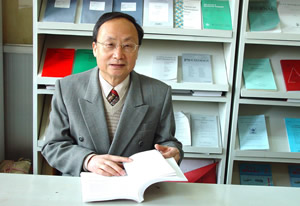成就榮譽
兼任中國運籌學會常務理事,中國決策科學學會理事,中國數學規劃學會理事, ZFM (德)評論員。蘭州大學1967年蘭州大學數學力學系本科畢業;1981年南京大學數學系研究生畢業(獲理學碩士學位, 研究方向:最最佳化理論與套用),一九八六年至一九八八年先後在美國華盛頓和康乃爾大學進修最最佳化。2001年獲“第五屆江蘇省優秀科技工作者”稱號。入選《世界名人錄》(Who’s Who in the World)(美),《21世紀2000位傑出知識分子》(2000 Outstanding Intellectuals of the 21st Century )(英)和2003年出版的《1000位偉大知識分子》(1000 Great Intellectuals)(英)。潘教授長期從事運籌學和最最佳化領域的教學和科研工作,在國內外核心學術刊物上發表論文七十篇以上及評論近百篇
貢獻
潘教授的早期研究興趣涉及數值逼近,擴大了解析幾何的傳統內容,對船舶和飛機製造自動化有重要價值;他提出的點列光順及擬合新方法套用於船體數學放樣取得了好效果,用相應軟體可使原來十幾個人需一個多月才能完成的工作縮短到幾小時。潘教授於上世紀七十年代後期轉向最佳化領域,證明了非線性最佳化擬牛頓方法的一階性,並建立了二階擬牛頓方法。他是國內最早涉足ODE方法的少數學者之一,求解等式約束最最佳化問題的ODE方法和理論的論文被第十二屆國際數學規劃會議列為邀請報告,在國內外有較大影響。線上性規劃領域,潘教授首次提出最優基的啟發式特徵刻劃,並推廣了BLAND有限主元規則;數值試驗表明新規則表現好於BLAND規則和其他有限規則。他提出二分單純形算法及若干基於最鈍角規則的非單調性算法,表現不僅好於現有的非單調性算法如CRISS-CROSS 算法,且好於傳統單純形算法。近年來,潘教授引入虧基概念,將單純形算法推廣到退化情形,為困擾學術界達半個世紀之久的退化問題的解決找到了新途徑;他在此基礎上建立的投影主元算法兼有投影算法和主元算法的特徵,第一次打破了這兩類算法的界限。其中“線性規劃的修正對偶投影主元算法”,在數值試驗中超過了Stanford 大學的著名最佳化軟體MINOS 5.51. 他的有關報告在第十六屆國際數學規劃會議及其後曾得到單純形算法之父G. B. Dantzig的高度評價(1997.8.洛桑)。
主要論著
[1] Practical finite pivoting rules for the simplex method, OR Spektrum, Vol. 12(1990), 219-225.
[2] Simplex-like method with bisection for linear programming, Optimization, Vol. 22(1991), No.5, 717-743.
[3] On safeguarding for global convergence of descent methods with inexact line searches, Proceedings of the Second Conference of Asian-Pacific Operations Research Societies (APORS) within IFORS (Beijing, China, August 27-30, 1991), Peking University Press, 1992, Beijing, 521-529.
[4] New ODE methods for equality constrained optimization (1): equations, Journal of Computational Mathematics, Vol. 10 (1992), No.1, 77-92.
[5] New ODE methods for equality constrained optimization (2): algorithms, Journal of Computational Mathematics, Vol. 10(1992), No.2, 129-146.
[6] Modification of Bland's pivoting rule, Numerical Mathemetics, Vol. 14(1992), No. 4, 379-381.
[7] A characterization of Developable surfaces and its application (coauthor: Ding-Qiuan Song), Journal of Southeast University , Vol. 23 , Suppl.(1993), 99-105.
[8] A variant of the dual pivoting rule in linear programming, Journal of Information and Optimization Sciences, Vol. 15(1994), No.3, 405-413.
[9] Ratio-test-free pivoting rules for a dual phase-I method, Proceedings of The Third Conference of Chinese SIAM, Tsinghua University Press, 1994, Beijing, China, 245-249.
[10] Composite phase-1 approach without measuring infeasibility, Proceedings of Second National Symposium on Mathematical Programming, Xidian University Press, 1994, Xian, China, 359-364.
[11] Ratio-test-free pivoting rules for the bisection simplex method ,Proceedings of National Conference on Decision Making Science, 1994, Shangrao, China, 24-29.
[12] Moore-Penrose inverse simplex algorithms based on successive
linear subprogramming approach (Coauthor: Zi-Xiang Ouyang), Numerical Mathemetics, Vol. 3(1994), No.2, 180-190.

